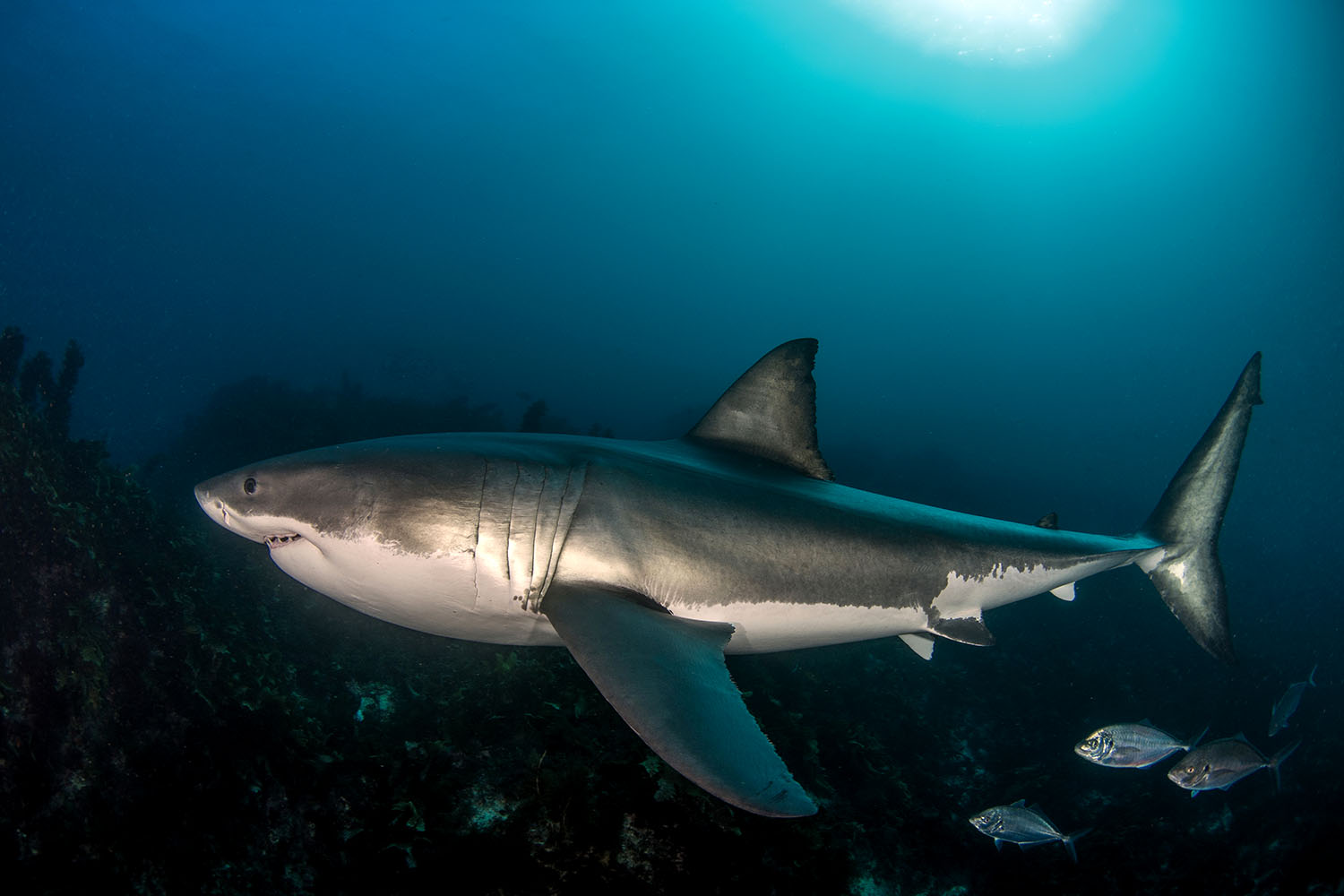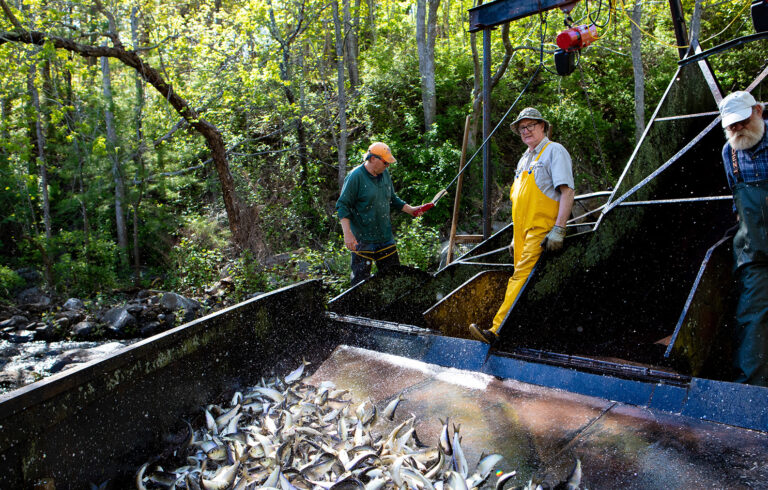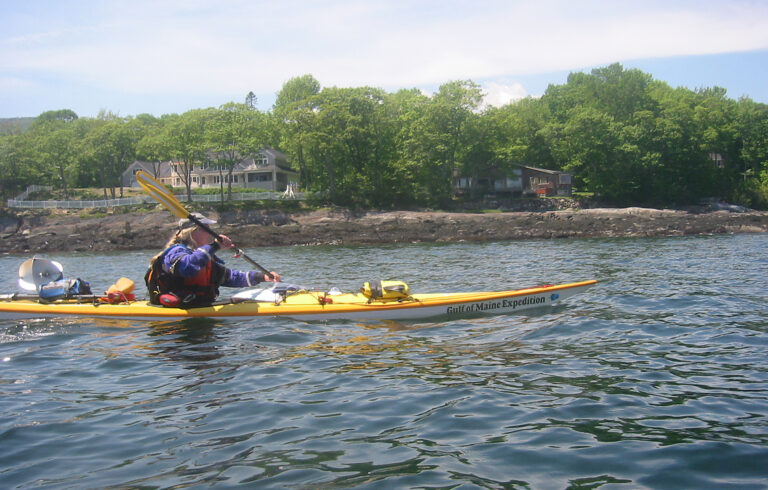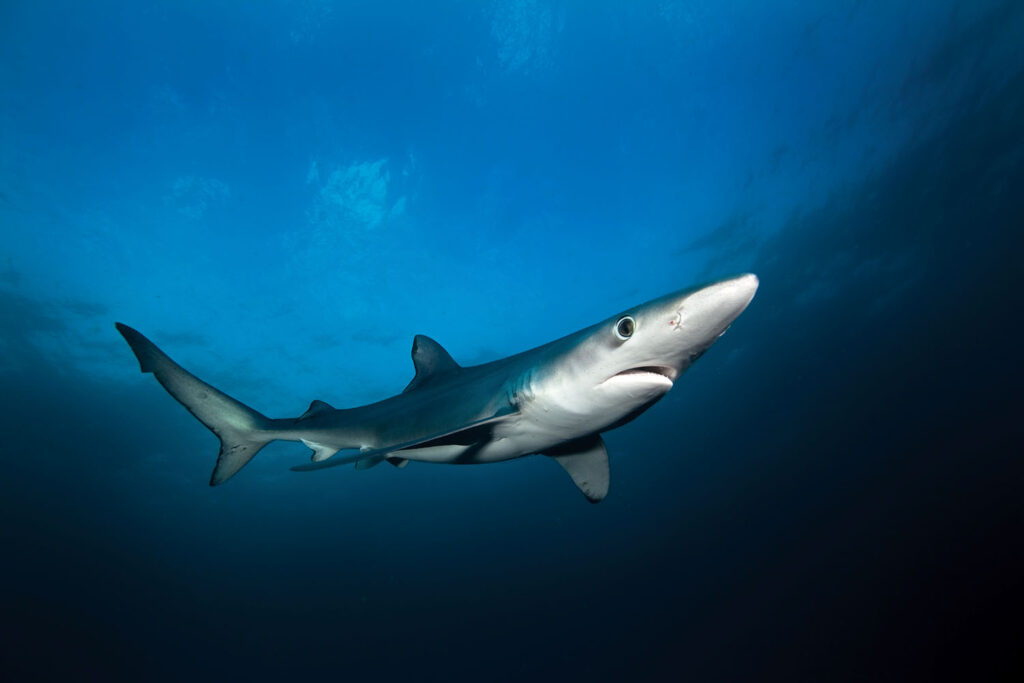
“Bastid took m’ hook!” Carts, a wiry guy with a cockeyed green cap and gaps in his smile, looked down at me from his precarious perch on the gunnel of the boat. I was about nine years old, and taken aback by his anger about the hook.
We were on a lobster boat off the east shore of Chebeague Island this sun-blazing summer afternoon. My father was somewhere flying fishermen in his seaplane to unknown destinations. I was stuffed away on the boat anchored in fairly shallow water within sight of Bangs Island. Carts, whose main job was hauling sardine seines, today was assigned to make sure I did not fall overboard and drown.
Having nothing else to do, he decided we’d go fishing. My experience with fishing included dropping handlines to catch pollock drifting lazily under floats at Bailey Island, and casting mackerel jigs from the wharf at Cliff Island to catch fish you could actually clean and eat. No pollock had ever come remotely close to biting off my hook. So Carts’s indignation about his hook seemed both appropriate and alarming. Though I soon realized it was mock disgruntlement, in preparation for teaching these fish a lesson they would never forget.
“OK, brothers, game’s on!” he said, or something like that, and set about changing line weight and hook, and maybe bait too.
What kind of a fish bites a hook clean off a handline?
Pretty soon Carts had a pretty powerful tug on his line. “Goddamn dogfish,” he said in between grunting, swearing, and manipulating his line in ways I had never imagined possible. Dogfish I had heard of but never seen, and imagined them to be some kind of streamlined sculpin, but less revolting.
As I watched, Carts hauled out of the green salt water a miniature shark! I was astounded. I had seen sharks on TV. And on our daily hops in the seaplane from Great Pond in Cape Elizabeth across outer Casco Bay and the Green islands to Bailey Island, my father had once or twice pointed out enormous fishes with dorsal fins motoring just beneath the surface, which he said were sharks. What kind, I never knew, but those fish were frighteningly huge, even compared to the 500-pound bluefin tunas I was used to seeing landed on the dock at Bailey Island. Until that afternoon on the boat at Chebeague, I had no idea a full-grown shark could be two feet long.
Soon a couple of other fishermen showed up and joined Carts’s fray. One after another they hauled up dogfish from the sandy bottom. After a while the deck of the boat was bloody and slippery with what seemed like dozens of gray and white, flipping, dorsal-finned sharks. Their skin felt sandpapery. Their overbite faces looked dangerous.
It’s not possible nearly 60 years later to know exactly what kind of dogfish we were catching, but a guess is they were spiny dogfish, the smallest and most abundant of the eight species of sharks seen with any regularity in Maine waters. The relatively warm summer water just off the island was the right spot for Squalus acanthias, which in summer tends to migrate north from the mid-Atlantic toward the Gulf of Maine, or south from Newfoundland as part of a subpopulation there.
Like many shark species, they move in groups segregated by sex and maturity. These spiny dogfish off Chebeague may have been mature females, who congregate in shallower water during summer while adult males ply deeper, more saline water.
I didn’t know it at the time, but Carts and the other fishermen all suspected the dogfish of interfering with their gear, which would explain the gleeful grudge he seemed to have against them. Their diet includes pelagic fish such as herring and mackerel, along with whatever else is available among crustaceans, squid, and ctenophores, which include different kinds of jellyfish.
The fishermen got part of their living catching herring, which in the early 1960s were declining steeply in Casco Bay, so maybe a certain competition was in play. In the last 50 years, the spiny dogfish have leaned more heavily on fish for their diet.
Spiny dogfish are one of the world’s most extensively harvested shark species, mainly for food, because they’re so widely distributed. In Northwest Atlantic waters, the International Union for Conservation of Nature and Natural Resources categorizes them as endangered. They are not on Maine’s current list of endangered and threatened species, however.
There is some evidence to suggest that seals are eating more spiny dogfish than they were in, say, the 1960s. Harbor seal and gray seal populations increased significantly in the Gulf of Maine over the first two decades of the 21st century, pointing to disruptions in ocean ecologies brought on by accelerating climate change, which affects everything. The seals eat spiny dogfish, which may well be attracting the seals which, in turn, are eaten by great white sharks.
It may never have occurred to Julie Holowach, when she went for a swim off Bailey Island in the summer of 2020, that she would be attacked by a shark. But the 63-year-old summer resident was killed while swimming toward the mouth of Mackerel Cove, which opens to deeper water. Her incredibly unfortunate death was, as far as anyone knows, the only fatal shark attack ever in Maine waters.
Great white sharks historically are not commonly reported in the Gulf of Maine. After spiny dogfish, the next most frequently seen sharks here, in descending order of frequency, are the blue shark, basking shark (“a whale trapped inside the body of a shark,” as shark expert Greg Skomal puts it), shortfin mako, porbeagle, thresher, sand tiger, and least seen among these, the great white. But this has been changing recently.
Never reported often, the great white shark population is thought to have plummeted during the 1970s and ‘80s to about a quarter of what it was at the time I was dogfishing off Chebeague. They were getting caught in commercial fishing operations and had become a target for sport fishermen, due in part to their sudden infamy as the deep-sea killer in the 1975 movie Jaws.
As studies, though still sketchy, mounted showing the great white’s decline, the National Marine Fisheries Service in 1997 outlawed fishing for them. Between the fishing ban and being attracted by a resurgence of seals due partly to the Marine Mammal Protection Act passed in 1972, great white shark populations in the Gulf of Maine have been increasing in the 21st century. Eleven great whites were tagged by researchers off Nova Scotia in 2019.
Most of the world’s 513 living species of shark are migratory, and they have lived practically everywhere in the world’s oceans since the first ones—about a foot long—showed up 380 million years ago. Like every living thing on the planet, each shark species has its own preferred habitats and ranges, though these in general are not well understood so far.
The most common large shark in the North Atlantic is thought to be the blue shark (Prionace glauca, 7 to 12 feet in length at maturity), with numerous individuals tracked from Newfoundland down to the Caribbean and all across the Atlantic to Europe and West Africa. A great white shark tagged at a seal colony off South Africa traveled the Indian Ocean to Australia and back again, a round trip of about 12,000 miles, in less than nine months.
Along with their close relatives the skates and rays, sharks are elasmobranchs—a subclass of cartilaginous fish, whose skeletons are made of cartilage rather than bone proper, making their bodies light and flexible. Unlike most other fish, sharks, skates, and rays have no swim bladder for buoyancy, and must keep moving to stay afloat. Sharks have five to seven gill slits through which water has to flow for them to breathe, another reason they famously must keep moving forward.
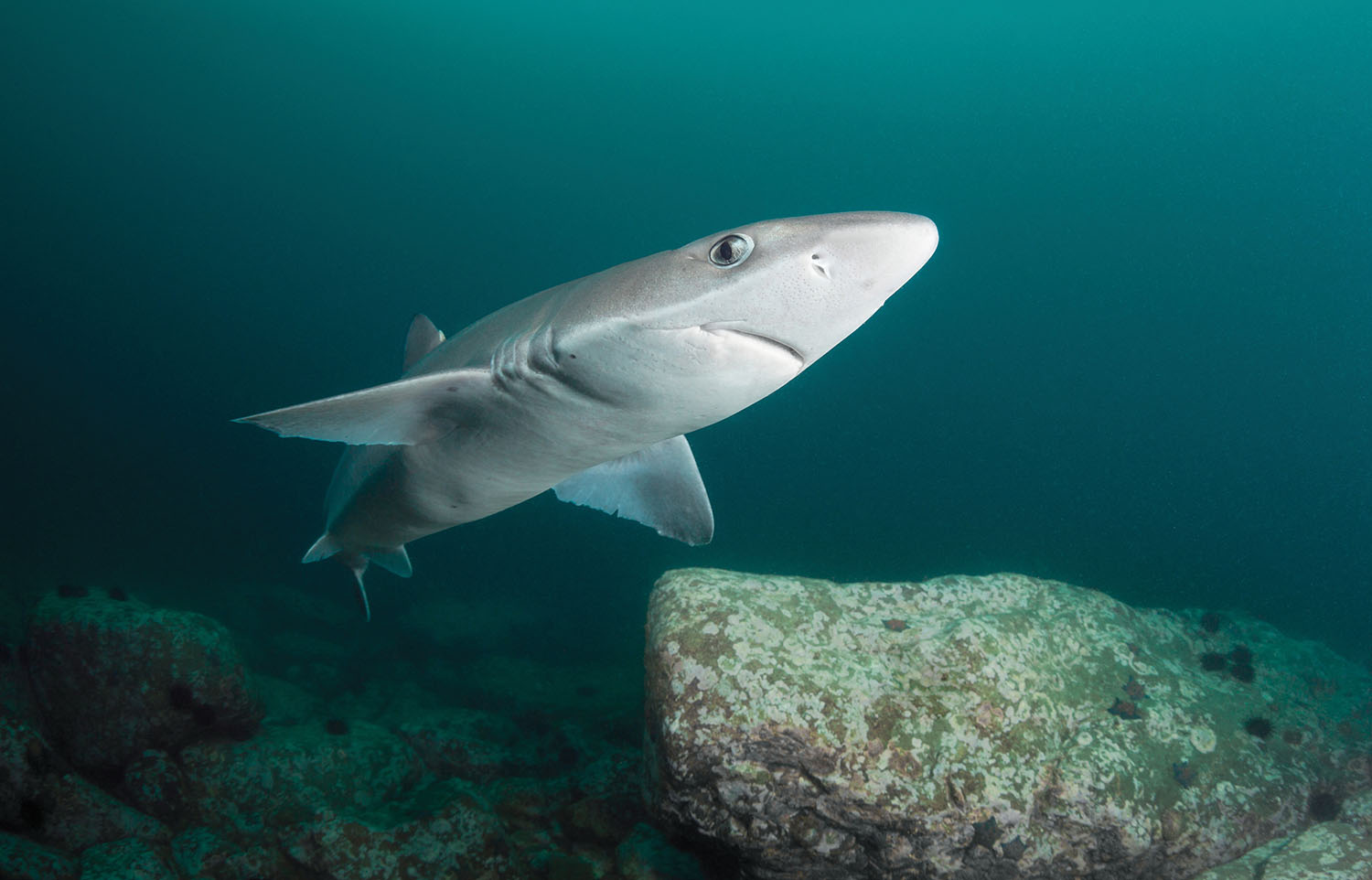
Shark skin is covered with tiny toothlike scales called denticles, which are pointed toward the tail; rub the skin toward the tail and it feels smooth, rub it toward the head, against the denticles, and it feels like sandpaper. Their powerful jaws are not part of the skull, enabling sharks to extend their mouths, in which are multiple rows of teeth. Some sharks’ teeth are molarlike, and others, like the great whites’, sharp, serrated triangles. Most sharks grow, lose, and regrow thousands of teeth over their lifetimes, which range from 30 years among sandbar sharks, to 80 for spiny dogfish, to upwards of a hundred among Greenland sharks. Some sharks lay eggs, though most, like great whites and spiny dogfish, give birth to live pups. They are relatively slow to mature, as fish go, and this, combined with fairly low reproductive rates overall, make them vulnerable to overfishing.
Sharks seem to see reasonably well in dusk-like light at short distances through their two eyes, which enable nearly 360-degree vision. Touch sensors provide information about water movement, and electroreceptors read electrical and magnetic fields, which they may use for navigation to breeding and feeding grounds. Their main perceptive faculty, though, is olfaction, scenting in acute detail prey, predators, and mates. Like much else concerning sharks, though, not a lot is understood about how this works.
Great white sharks (Carcharodon carcharias) are becoming better and better studied with improving tagging and satellite technology, but still pose many questions for researchers like Skomal, head of the Massachusetts Shark Research Program. Great whites are highly migratory. At least some return to the same feeding sites, eating mainly fish when younger and adding larger prey, including seals and dolphins, to their diet as they grow larger. But much remains to be discovered about them.
The attack on Julie Holowach was, by all accounts, almost certainly a matter of the shark mistaking her for a seal or sea lion. Skomal, in his Shark Handbook, notes that fewer than ten attacks of great white sharks on humans are reported per year. Even then, the shark almost never tries to eat the human, though the wounds can be severe enough to kill.
Worldwide, about 70 attacks by sharks of all kinds on humans are reported per year, with an estimated 25 to 50 unreported, and an average of four fatalities. According to the International Shark Attack File of the Florida Museum, there were 64 confirmed unprovoked shark attacks worldwide in 2019; five attacks resulted in deaths, two of which were classified as unprovoked.
Most shark attacks happen to surfers, as well as swimmers and divers, in Florida, Australia, Hawaii, South Africa, South Carolina, and California. About 38 percent of unprovoked shark attacks are by great whites, 13 percent by tiger sharks, and 12 percent by bull sharks, with those attacks resulting in death about 25 percent of the time.
Skomal’s research since 2009, including his recent focus on white shark predatory behavior off Cape Cod, indicates the great white shark population has been rising in New England waters; in 2019 he tagged 50 off Cape Cod, the most ever. Along with more sharks come more chances of close encounters with humans. Six unprovoked shark attacks have been reported in Massachusetts since 1837, according to the International Shark Attack File, five of them since 2012; the only two deaths were in 1936 and in 2018, when a boogie boarder was killed.
Fishermen have long been the best source of information about shark presences, whether reporting sightings or helping with tagging projects, and that is likely to be the case for a long time. Two Stonington lobstermen were hauling traps northeast of Isle au Haut in September 2020 when a shark followed one of the traps up out of the water and tried to bite it. The fish was 12 to 15 feet long and “as big around as a 55-gallon drum,” one of the men told a reporter. The shark rose up as if to make a second pass at the trap sitting on the boat’s gunnel, lurked around, and then swam off.
“It was startling, I guess,” one of the men said, with Downeast understatement almost as old as the elasmobranchs themselves.
What kind of shark went after the lobster trap was not known. The lobstermen said that earlier in the summer they’d seen dead seals with what might have been shark bites. It’s the kind of clue researchers can use to unlock the many unanswered questions about one of the world’s oldest, most mysterious, fascinating living beings.
Dana Wilde is a nature columnist, book reviewer, former news editor, and college professor. His recent books are A Backyard Book of Spiders in Maine and Winter: Notes and Numina from the Maine Woods. He lives in Troy.

